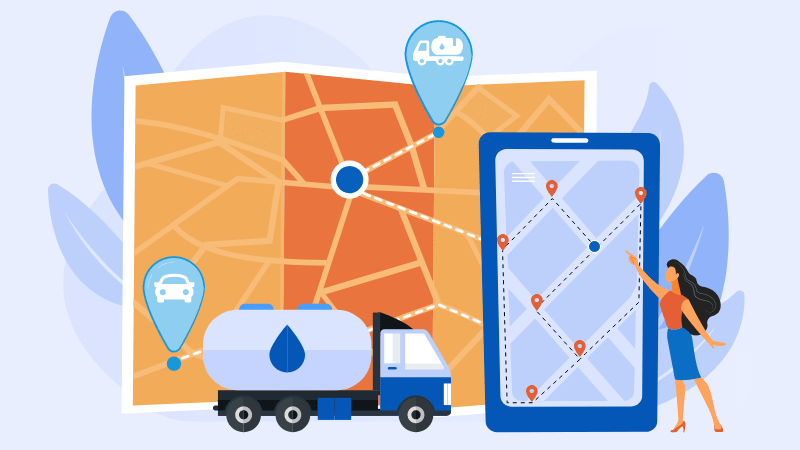Blockchain Technology
10 Things About Delivery Route Planning and Optimization Software
Route optimization software helps companies around the world to maximize the delivery of their orders. According to research by Market Research Future

Route optimization software helps companies around the world to maximize the delivery of their orders. According to research by Market Research Future, the global market for route optimization applications will reach $5 billion (approximately $27 billion) in 2023, with an annual growth of 11.4%.
The fastest growing sectors include consumer packaged goods (CPG) and retail, with many companies using free delivery route planner to streamline their operations.
If you are looking for a simple solution to lower costs, improve route efficiency and provide real-time analytics, check out below for a list of free routing systems available today in Brazil.
5 Benefits of Routing Software
Small businesses or any fuel delivery business can use routing programs to manage vehicle schedules and routes, which helps improve distribution processes and driver performance. The best free routing software uses powerful management solutions to minimize driving time and fuel consumption and improve deliveries.
These software can be used in combination with other solutions such as logistics software, delivery management tools and fleet management systems.
Below, see some of the main benefits that companies can obtain when using routing software to optimize their deliveries:
1. Greater capacity for route planning
Route planning software allows companies to take advantage of scenario modeling technologies to calculate different variables to choose the most efficient and fastest route. With them, drivers receive step-by-step instructions and take advantage of dynamic route updates when the predetermined path is no longer efficient.
2. Time saving
On routes with multiple stops, it is vital to plan the one that saves the most time. Time is critical in customer service and quality control management. Delayed deliveries can negatively impact customers, profitability and operating costs.
In addition, when orders are delivered after the deadline, service level agreements (ANS) are broken and there may be a need to refund customers. The best free delivery routing software ensures that all orders are delivered on time.
3. Greater visibility of logistics
With routing systems, companies can increase the visibility of their logistical assets, such as vans, trucks and drivers, and have better coordination to better use their resources, considerably increasing the number of completed deliveries.
4. Integration with CRM
Integrations with customer relationship management (CRM) software allow you to automatically extract customer addresses to provide the most efficient routes.
CRM software eliminates errors in data synchronization by providing up-to-date information from your customers’ database. The best free delivery routing software will identify optimal routes with multiple stops from distribution centers to delivery locations.
5. Better fleet and driver management
Cloud-based platforms connect drivers, customer service teams and operations managers with real-time metrics to ensure everyone is on top of everything else.
Routing systems help reduce fuel costs, can increase productivity and profitability, and offer help in creating reliable management reports for greater visibility into the entire process.
5 Tips to Create your Route
Route planning is one of the most important tasks of a fleet manager. There are many variables involved, vehicles and drivers available, vehicle capacity, time, place of delivery and many others.
Thus, scripting manually is a time consuming task, based mainly on your experience and common sense. However, this does not guarantee that the chosen route is in fact the best.
We’ve selected 5 tips to help you create your routes!
1. Group close customers
When organizing a route, you should try to group customers with close addresses into blocks or zones, reducing traffic time between one delivery and another. Thus, the process becomes more efficient and vehicles travel a shorter distance, which for you will result in lower costs!
2. Pay attention to the service window
Reaching the customer at a time when he is not available to receive the goods is one of the major operational problems that result in the need for transfers. Therefore, when setting up your delivery route, contact the customer, record the best time for delivery and try to perform the service in that service window to avoid having to return later.
3. Create a planning routine
Having a well-defined planning routine, with well-organized communication between the logistics and commercial sectors, is essential for the success of the operation. Check daily the orders that need to be delivered, the availability of vehicles and drivers. Have a standardized process that everyone understands and gets to work.
4. Use the biggest vehicles
Try to use the vehicles with the highest load capacity initially, as this way you minimize the amount of vehicles in deliveries, reducing operating costs. Care must be taken to ensure that the vehicle’s maximum capacity is respected and that the quantity of deliveries is compatible with the driver’s journey time.
5. Use scripting software
Technology comes to help you in your day to day to perform repetitive tasks faster. So be sure to use it. Routing software can be your great ally for creating optimal routes quickly.
They take orders from your commercial system and automatically distribute them among available vehicles, based on load capacity, customer addresses, service windows and many other variables.
Thus, you’ll be able to create shorter distance routes and serve a greater number of customers!
-

 Technology4 days ago
Technology4 days agoEnhancing Lead Management and Text Marketing with Launch Control’s All-in-One CRM
-

 Destinations3 days ago
Destinations3 days agoSave Money in London: Insider Tips for Budget Travellers
-

 USA News3 days ago
USA News3 days agoWhat Is The Current Us Elections Rating And Who Is Leading The Polls?
-

 Europe News3 days ago
Europe News3 days agoSee Rome on a Budget: History and Culture Without the Cost
-

 Travel3 days ago
Travel3 days agoHow to Make Friends in Southeast Asia Hostels: A Guide for Solo Travellers
-

 Climate Change3 days ago
Climate Change3 days agoCuba Faces Nationwide Power Grid Collapse Amidst Ongoing Crisis
-

 Travel3 days ago
Travel3 days agoSafe Travel in Mexico: Tips for a Hassle-Free Trip
-

 Destinations3 days ago
Destinations3 days agoArgentina Travel Guide: Tango, Wine, and Natural Wonders


















